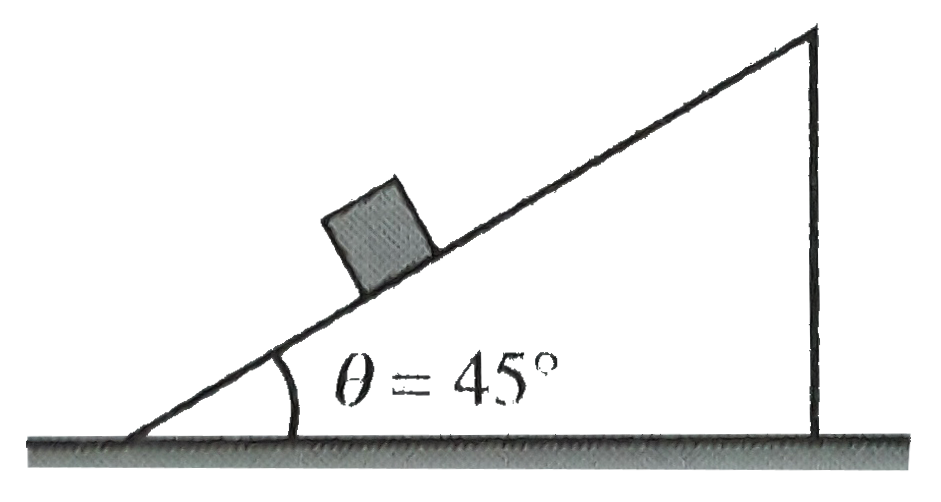A 2kg object is slide along a rough floor (coefficient of sliding friction =0.3)with initial volocity (10m/s)ˆi. Describe the motion of the object relation to car assuming that the coefficient of static friction is greater than 0.5.
To solve the problem, we will analyze the motion of a 2 kg object sliding on a rough floor inside a car that is accelerating. We will consider the effects of friction and the non-inertial frame of reference due to the car's acceleration.
1. Identify Given Data:
- Mass of the object, m=2kg
- Initial velocity of the object, u=10m/s
- Coefficient of kinetic friction, μk=0.3
- Coefficient of static friction, μs>0.5
- Acceleration of the car, acar=5m/s2
2. Determine the Forces Acting on the Object:
- The gravitational force acting on the object is Fg=mg=2×10=20N.
- The normal force N acting on the object is equal to the gravitational force since there is no vertical acceleration, thus N=20N.
- The force of kinetic friction Fk is given by:
Fk=μkN=0.3×20=6N
3. Calculate the Deceleration Due to Friction:
- The deceleration af caused by friction is given by:
af=Fkm=62=3m/s2
4. Determine the Effective Acceleration of the Object:
- Since the car is accelerating, we need to consider the pseudo force acting on the object. The pseudo force Fp is:
Fp=macar=2×5=10N
- The effective acceleration aeff of the object relative to the car is:
aeff=−acar−af=−5−3=−8m/s2
5. Calculate the Time Until the Object Stops Relative to the Car:
- Using the equation of motion v=u+at, where v=0 (the object stops):
0=10−8t⟹t=108=1.25s
6. Calculate the Distance Traveled by the Object Before Stopping:
- Using the equation s=ut+12at2:
s=10×1.25+12(−8)(1.25)2
s=12.5−5=7.5m
7. Analyze the Motion in Relation to the Car:
- Since the coefficient of static friction is greater than 0.5, the object will not slide relative to the car after it comes to rest. The static friction will be sufficient to keep the object at rest with respect to the accelerating car.
Conclusion:
The object will slide for a distance of 7.5 m before coming to rest relative to the car after 1.25 seconds. Once it stops, it will remain at rest relative to the car due to the sufficient static friction.
- Mass of the object, m=2kg
- Initial velocity of the object, u=10m/s
- Coefficient of kinetic friction, μk=0.3
- Coefficient of static friction, μs>0.5
- Acceleration of the car, acar=5m/s2
- The gravitational force acting on the object is Fg=mg=2×10=20N.
- The normal force N acting on the object is equal to the gravitational force since there is no vertical acceleration, thus N=20N.
- The force of kinetic friction Fk is given by:
Fk=μkN=0.3×20=6N
- The deceleration af caused by friction is given by:
af=Fkm=62=3m/s2
- Since the car is accelerating, we need to consider the pseudo force acting on the object. The pseudo force Fp is:
Fp=macar=2×5=10N
- The effective acceleration aeff of the object relative to the car is:
aeff=−acar−af=−5−3=−8m/s2
- Using the equation of motion v=u+at, where v=0 (the object stops):
0=10−8t⟹t=108=1.25s
- Using the equation s=ut+12at2:
s=10×1.25+12(−8)(1.25)2
s=12.5−5=7.5m
- Since the coefficient of static friction is greater than 0.5, the object will not slide relative to the car after it comes to rest. The static friction will be sufficient to keep the object at rest with respect to the accelerating car.
The object will slide for a distance of 7.5 m before coming to rest relative to the car after 1.25 seconds. Once it stops, it will remain at rest relative to the car due to the sufficient static friction.
Topper's Solved these Questions
- LAWS OF MOTIONBook:DC PANDEY ENGLISHChapter:LAWS OF MOTIONExercise:Objective Question
Explore 32 Videos
- LAWS OF MOTIONBook:DC PANDEY ENGLISHChapter:LAWS OF MOTIONExercise:Comprehension
Explore 9 Videos
- LAWS OF MOTIONBook:DC PANDEY ENGLISHChapter:LAWS OF MOTIONExercise:Assertion And Reason
Explore 28 Videos
- KINEMATICS 1Book:DC PANDEY ENGLISHChapter:KINEMATICS 1Exercise:INTEGER_TYPE
Explore 15 Videos
- LAWS OF THERMODYNAMICSBook:DC PANDEY ENGLISHChapter:LAWS OF THERMODYNAMICSExercise:Level 2 Subjective
Explore 18 Videos
Similar Questions
A 2kg object is sliding along the frictionless floor with initial velocity (10m/s)ˆi (a) Describe the motion of the object relation to car (b) when does the object reach its original position relative to the box car.
View SolutionA 2kg object is slide along the frictionless floor with intial transverse volocity (10m/s)ˆk (a) Describe the motion (a) in car's frame and (b) in ground frame.
View SolutionA body is moving along a rough horizontal surface with an initial velocity 6m/s m If the body comes to rest after travelling 9 m , then the coefficient of sliding friction will be
View SolutionA block slides on ice with a velocity of 5m/s comes to rest after moving through a distance of 13.5m . Find the coefficient of friction ?
View SolutionA crate of mass 20 kg is sliding across a wooden floor. The coefficient of kinetic friction between the crate and the floor is 0.3.
Determine the magnitude of the friction force acting on the crate.
View SolutionA crate of mass 100 kg rests on the floor. The coefficient of static friction is 0.4. If a force of 250 N(parallel to the floor) is applied to the create, what's the magnitude of the force of static friction on the crate ?
View SolutionAn unbanked curve has a radius of 60m. The maximum speed at which a car can make a turn if the coefficient of static friction is 0.75 , is
View SolutionA block of mass m=3kg slides on a rough inclined plane of cofficient of friction 0.2 Find the resultant force offered by the plane on the block

View SolutionA marble block of mass 2 kg lying on ice when given a velocity of 6m/s is stopped by friction in 10s. Then the coefficient of friction is
View SolutionA marble block of mass 2 kg lying on ice when given a velocity of 6m/s is stopped by friction in 10s. Then the coefficient of friction is
View Solution